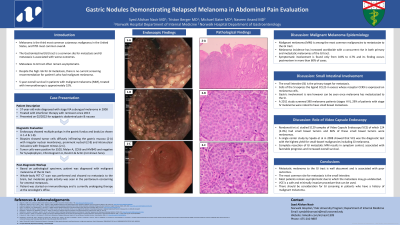Back


Poster Session D - Tuesday Morning
Category: Stomach
D0706 - Gastric Nodules Demonstrating Relapsed Melanoma in Abdominal Pain Evaluation
Tuesday, October 25, 2022
10:00 AM – 12:00 PM ET
Location: Crown Ballroom

Has Audio

Syed Alishan Nasir, MD
Norwalk Hospital
Norwalk, CT
Presenting Author(s)
Syed Alishan Nasir, MD, Triston Berger, MD, Michael Slater, DO, Naveen Anand, MD
Norwalk Hospital, Norwalk, CT
Introduction: Melanoma is the third most common cutaneous malignancy in the United States, and fifth most common overall. Common sites for metastasis include the skin, brain, liver, and gastrointestinal (GI) tract. Although involvement of the GI tract in metastatic disease is common, it is typically found postmortem and only 0.8%-4.7% of patients have GI symptoms. Within in the GI tract, the small bowel is the most common site of metastasis. Gastric metastasis is a relatively rare occurrence and is generally associated with poor prognosis. Here we discuss a patient who presented with nonspecific epigastric pain and nausea who was found to have gastric melanoma based on biopsy of gastric nodules found on esophagogastroduodenoscopy (EGD).
Case Description/Methods: 57-year-old male with history of stage IIIa melanoma in 2008 in remission presented to clinic for evaluation of nausea, bloating, and epigastric pain of 2-week duration. Review of systems was unremarkable. Symptoms were refractory to dietary modification and esomeprazole. An EGD was pursued and identified multiple fundic gland polyps (not present on EGD 2019) which were biopsied. Pathology supported melanoma through positivity for S100, Melan-A, HMB45 and CD56. After diagnosis, CT abdomen and pelvis showed extensive peritoneal carcinomatosis, hepatic lesions, and pulmonary nodules with further biopsies supporting melanoma. The patient did not have any new skin lesions. He was started on ipilimumab and nivolumab and continues to receive treatment.
Discussion: Malignant melanoma (MM) is one of the most common malignancies to metastasize to the GI tract. In the GI tract, metastasis to the small bowel is most common. The ability of MM to spread to the small intestine has been suggested to be a result of the increased expression of CCR9 chemokine receptor on melanoma cells for which its ligand CCL25 is highly expressed in the small intestine. In most cases, once the cancer has metastasized to the small bowel, it will then spread into the stomach and colon. Hence, for patients who have MM identified in the stomach, there should be a strong suspicion for presence of metastasis in the small bowel. Currently no screening is indicated for GI melanoma, and symptoms are only observed in a minority of patients. Given the poor prognosis associated with MM, this presentation reinforces the need to have a higher level of concern for GI metastasis in patients with history of MM.

Disclosures:
Syed Alishan Nasir, MD, Triston Berger, MD, Michael Slater, DO, Naveen Anand, MD. D0706 - Gastric Nodules Demonstrating Relapsed Melanoma in Abdominal Pain Evaluation, ACG 2022 Annual Scientific Meeting Abstracts. Charlotte, NC: American College of Gastroenterology.
Norwalk Hospital, Norwalk, CT
Introduction: Melanoma is the third most common cutaneous malignancy in the United States, and fifth most common overall. Common sites for metastasis include the skin, brain, liver, and gastrointestinal (GI) tract. Although involvement of the GI tract in metastatic disease is common, it is typically found postmortem and only 0.8%-4.7% of patients have GI symptoms. Within in the GI tract, the small bowel is the most common site of metastasis. Gastric metastasis is a relatively rare occurrence and is generally associated with poor prognosis. Here we discuss a patient who presented with nonspecific epigastric pain and nausea who was found to have gastric melanoma based on biopsy of gastric nodules found on esophagogastroduodenoscopy (EGD).
Case Description/Methods: 57-year-old male with history of stage IIIa melanoma in 2008 in remission presented to clinic for evaluation of nausea, bloating, and epigastric pain of 2-week duration. Review of systems was unremarkable. Symptoms were refractory to dietary modification and esomeprazole. An EGD was pursued and identified multiple fundic gland polyps (not present on EGD 2019) which were biopsied. Pathology supported melanoma through positivity for S100, Melan-A, HMB45 and CD56. After diagnosis, CT abdomen and pelvis showed extensive peritoneal carcinomatosis, hepatic lesions, and pulmonary nodules with further biopsies supporting melanoma. The patient did not have any new skin lesions. He was started on ipilimumab and nivolumab and continues to receive treatment.
Discussion: Malignant melanoma (MM) is one of the most common malignancies to metastasize to the GI tract. In the GI tract, metastasis to the small bowel is most common. The ability of MM to spread to the small intestine has been suggested to be a result of the increased expression of CCR9 chemokine receptor on melanoma cells for which its ligand CCL25 is highly expressed in the small intestine. In most cases, once the cancer has metastasized to the small bowel, it will then spread into the stomach and colon. Hence, for patients who have MM identified in the stomach, there should be a strong suspicion for presence of metastasis in the small bowel. Currently no screening is indicated for GI melanoma, and symptoms are only observed in a minority of patients. Given the poor prognosis associated with MM, this presentation reinforces the need to have a higher level of concern for GI metastasis in patients with history of MM.

Figure: Gastric nodules secondary to malignant melanoma
Disclosures:
Syed Alishan Nasir indicated no relevant financial relationships.
Triston Berger indicated no relevant financial relationships.
Michael Slater indicated no relevant financial relationships.
Naveen Anand indicated no relevant financial relationships.
Syed Alishan Nasir, MD, Triston Berger, MD, Michael Slater, DO, Naveen Anand, MD. D0706 - Gastric Nodules Demonstrating Relapsed Melanoma in Abdominal Pain Evaluation, ACG 2022 Annual Scientific Meeting Abstracts. Charlotte, NC: American College of Gastroenterology.

